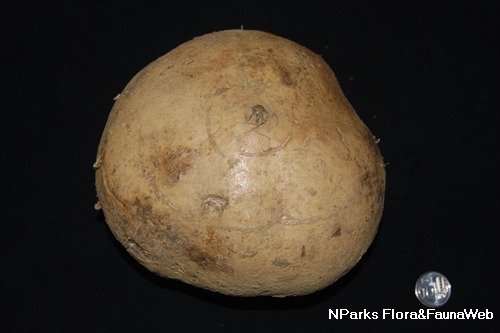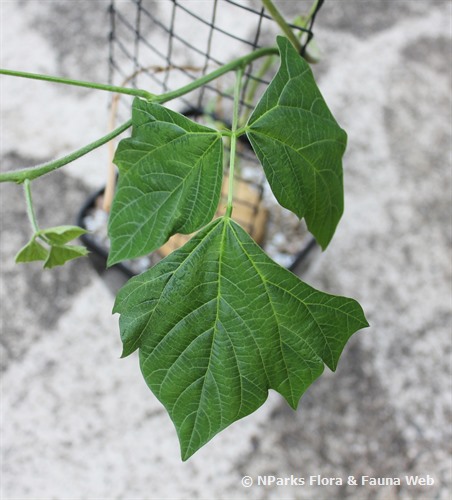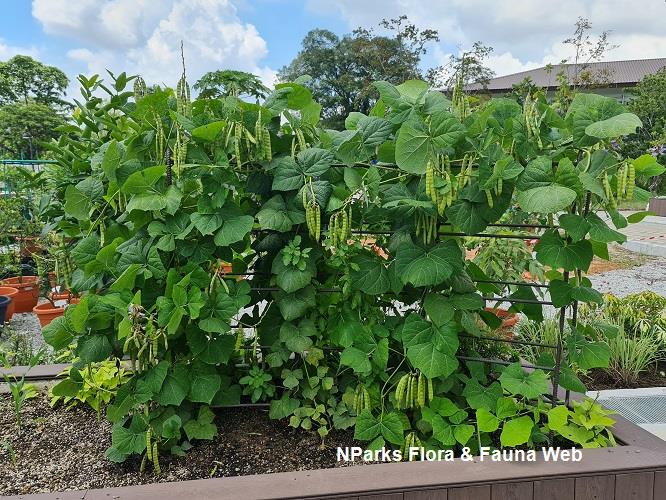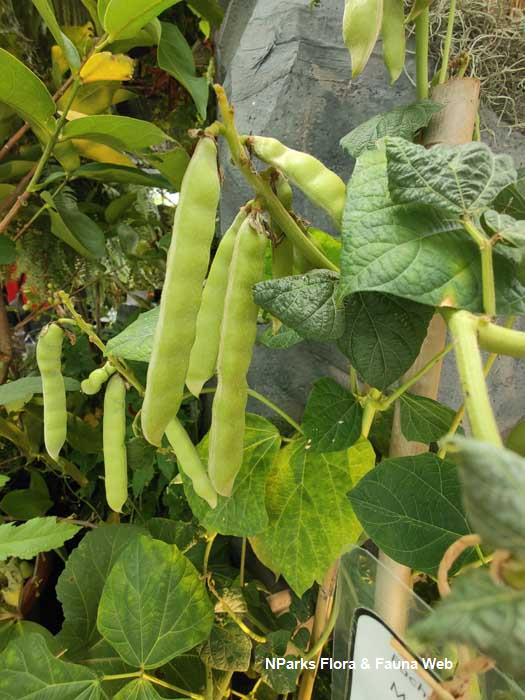
Back
Pachyrhizus erosus (L.) Urb.
| Family Name: | Fabaceae (Leguminosae) |
| Synonyms: | Cacara erosa, Dolichos bulbosus |
| Common Name: | Bang Kwang, Bangkuang, Jicama, Mexican Turnip, Sengkuang, Yam Bean |
Bang Kwang (Pachyrhizus erosus) has edible tuberous root that is spindle-shaped like turnip with light brown skin and white flesh. This climbing or trailing vine has trifoliate, stingray-shaped leaflets.
Name
Classifications and Characteristics
| Plant Division | Angiosperms (Flowering Seed Plants) (Dicotyledon) |
|---|---|
| Plant Growth Form | Climber |
| Lifespan (in Singapore) | Annual |
| Mode of Nutrition | Autotrophic |
| Maximum Height | 5 m |
Biogeography
| Native Distribution | Mexico, Central America |
|---|---|
| Native Habitat | Terrestrial |
| Preferred Climate Zone | Tropical |
| Local Conservation Status | Non-native (Horticultural / Cultivated Only) |
Description and Ethnobotany
| Growth Form | Vine up to 5 m long. |
|---|---|
| Roots | Tuberous roots resembling turnips, with light brown skin and white flesh. |
| Foliage | Trifoliate, compound leaves with large, stingray-shaped leaflets. |
| Flowers | Purple and white, pea-shaped flowers borne on flower clusters known as racemes. Inflorescence arising at the nodes along the vine. |
| Fruit | Seedpods covered with hairs, hairless when mature. The pods are ribbed. |
| Cultivation | It grows best in moist, but well-drained soil. Allow the plants to grow for at least 5 months in order to obtain 5-16 cm wide tubers. |
| Etymology | The genus epithet Pachyrhizus means having thick roots. The specific epithet erosus means jagged. |
| Ethnobotanical Uses | Edible Plant Parts : Edible Storage Organs Food (Fruit or Vegetable): The round storage tuber has a crisp, sweet taste and is eaten raw or cooked in stir-fries and soups. It is low in calories, but high in fiber and vitamin C. The skin of the tuber must be removed before consumption because it contains toxic compounds. The seeds, flowers and leaves also contain toxins. In Singapore, it is eaten raw in Rojak by mixing it with ground peanuts and Rojak sauce. It is also stir-fried and then simmered for use as filling in Popiah and Kueh Pie Ti. In Mexico, it is popular to eat the slices with lime juice, salt and chili powder. The ideal storage temperature for tubers is about 15 degrees Celsius. |
Landscaping Features
| Desirable Plant Features | Ornamental Flowers |
|---|---|
| Thematic Landscaping | Economic Garden |
Fauna, Pollination and Dispersal
| Pollination Method(s) | Abiotic (Self-Pollinated) |
|---|
Plant Care and Propagation
| Light Preference | Full Sun |
|---|---|
| Water Preference | Moderate Water |
| Plant Growth Rate | Fast to Moderate |
| Rootzone Tolerance | Easy to Grow, Fertile Loamy Soils, Moist Soils, Well-Drained Soils |
| Propagation Method | Seed, Storage Organ (Tuberous Root) |
Foliar
| Foliage Retention | Evergreen |
|---|---|
| Mature Foliage Colour(s) | Green |
| Mature Foliage Texture(s) | Smooth |
| Prominent Young Flush Colour(s) | Green |
| Young Flush Texture(s) | Smooth |
| Foliar Type | Compound (Trifoliate) |
| Foliar Arrangement Along Stem | Alternate |
| Foliar Attachment to Stem | Petiolate |
| Foliar Shape(s) | Non-Palm Foliage (Ovate) |
| Foliar Venation | Pinnate / Net |
| Foliar Margin | Serrate / Toothed |
| Foliar Apex - Tip | Acuminate |
| Foliar Base | Attenuate |
Floral (Angiosperm)
| Flower & Plant Sexuality | Bisexual Flowers |
| Flower Colour(s) | Purple |
|---|---|
| Flower Texture(s) | Smooth |
| Flower Grouping | Cluster / Inflorescence |
| Flower Location | Axillary |
| Flower Symmetry | Bilateral |
| Individual Flower Shape | Papilionaceous / Pea-shaped |
| Inflorescence Type | Raceme |
Fruit, Seed and Spore
| Mature Fruit Colour(s) | Green |
|---|---|
| Mature Fruit Texture(s) | Hairy / Hirsute |
| Fruit Classification | Simple Fruit |
| Fruit Type | |
| Mature Seed Colour(s) | Brown |
| Mature Seed Texture(s) | Smooth |
| Seed Quantity Per Fruit | Moderate (6-10) |
Image Repository
Others
| Master ID | 32613 |
|---|---|
| Species ID | 7025 |
| Flora Disclaimer | The information in this website has been compiled from reliable sources, such as reference works on medicinal plants. It is not a substitute for medical advice or treatment and NParks does not purport to provide any medical advice. Readers should always consult his/her physician before using or consuming a plant for medicinal purposes. |










